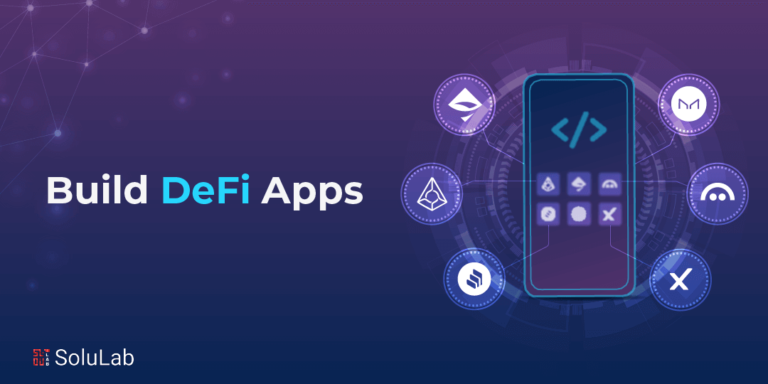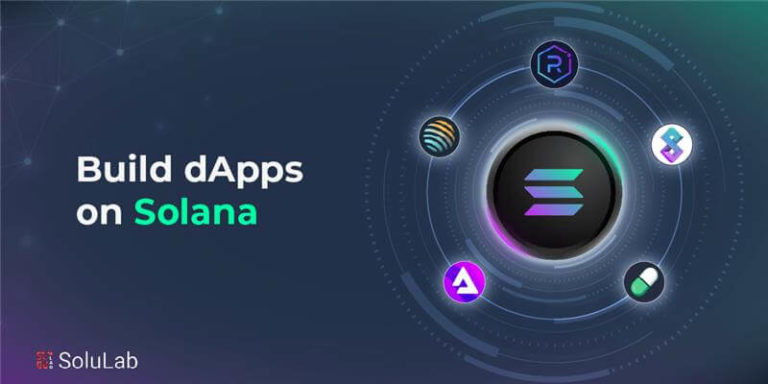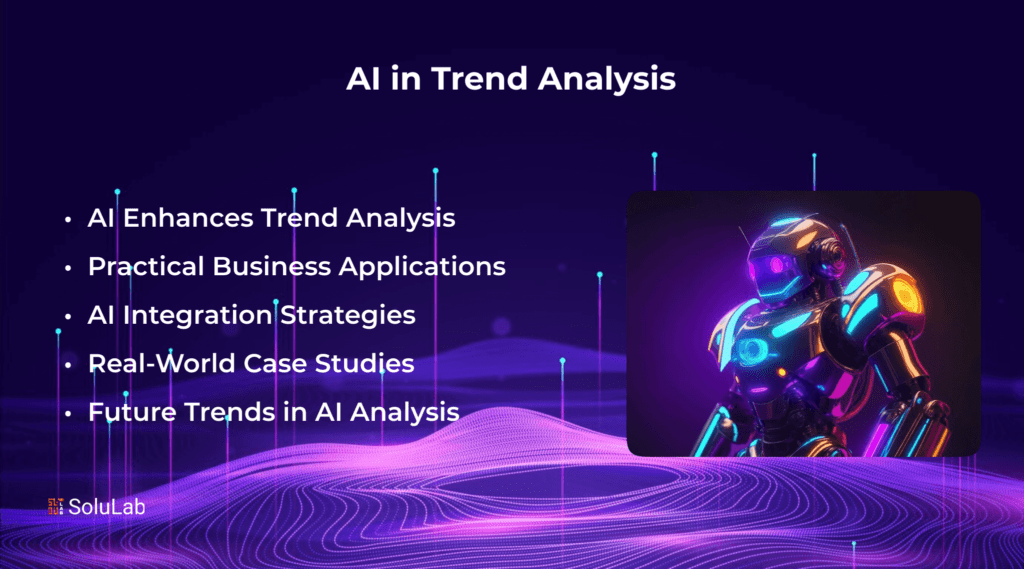
Understanding patterns and trends in data is more important than ever in today’s fast-paced, data-driven world, as it acts as a compass for businesses and individuals navigating the immense sea of information. With the introduction of artificial intelligence (AI), trend analysis—a method for locating and examining temporal trends in data—has seen substantial development. It is now a pillar for creating original ideas and streamlining the decision-making process.
The complex interactions between artificial intelligence (AI) and trend analysis are examined in this article, which also provides insights into the revolutionary effects of AI components like machine learning (ML) and natural language processing (NLP) in analytical procedures. We explore a wide range of AI methods, including data mining, predictive analytics, and deep learning, and explain how they are used to foresee trends and extract insights in a variety of complex fields, including banking, healthcare, and climate research.
We examine practical uses of AI in trend analysis that provide previously unheard-of predictive power and strategic insights, paving the way for innovations in everything from market research to e-commerce and healthcare. We also discuss the difficulties that arise, such as data privacy and ethical issues, and offer best practices and strategies to lessen them.
Furthermore, by investigating the potential effects of cutting-edge technologies like quantum computing on trend forecasting and analysis, we shed light on the future directions and possible advances in artificial intelligence in trend analysis.
This article promises a blend of clarity and depth, revealing specific perspectives and provoking contemplation on the developing synergy between AI in trend analysis. It is suitable for anyone interested in technology, experienced analysts, or simply curious minds trying to understand the intricate weave of AI in trend analysis.
What is Trend Analysis?
Trend analysis is a crucial analytical approach that is widely used in a variety of industries, including marketing, finance, and economics, to understand identifiable trends across a wide range of datasets. With its capacity to systematically analyze the direction and size of changes within data, it provides insight into existing market dynamics and aids in the making of accurate forecasts and well-informed judgments.
It’s common knowledge in trading that a market trend is a trader’s best ally. This claim emphasizes how crucial trend research is for navigating the intricate world of market trends. If traders follow the market’s harmonic rhythm, they may make significant profits, but only if they do thorough underlying research and draw conclusions based on a thorough grasp of the complex forces at play in the market. Trend analysis is used in the financial industry to maximize profits by matching investments to current market trends up until there is solid evidence of a potential change.
How Trend Analysis Might Benefit Companies?
Today’s corporate environment is dynamic and complicated, and navigating it demands a clear awareness of new trends and the ability to anticipate them. Businesses of all sizes may remain ahead of the competition, predict client demands, and make more strategic, well-informed decisions by using trend forecasting. The integration of artificial intelligence and ML enhances this capacity by providing a more sophisticated analysis of patterns and the capacity to anticipate future trends with increased accuracy and dependability.
Businesses often use a variety of trend reports in the context of Internet commerce to spot new trends and comprehend consumer behavior. It is essential to recognize, meanwhile, that consumer behavior might fluctuate dramatically throughout various online platforms. Therefore, using consumer insights across entities has inherent limitations and may result in goals and objectives that are not aligned. Consequently, it is imperative that every company use its machine learning technologies so that they may do a thorough study tailored to their consumer base and operational requirements. This methodology guarantees that the strategies and insights obtained are not only pertinent but also aligned with their distinct company goals and consumer expectations.
Important AI Components for Trend Analysis
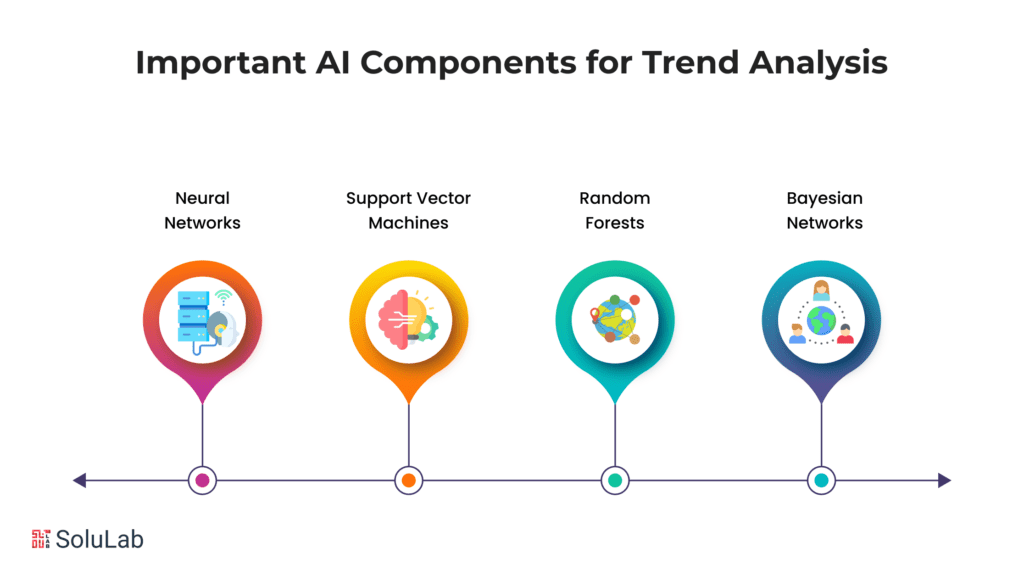
An accurate machine learning algorithm must be included in order to fully utilize artificial intelligence in trend forecasting. This algorithm is the foundation of intelligent forecasting by closely examining past data to find patterns and trends. Acknowledging these tendencies is critical since it allows the algorithm to forecast future trends with precision, influencing the strategic course of companies.
However, choosing the right algorithm is crucial. Every machine learning algorithm has its own set of advantages and disadvantages, so selecting one that perfectly fits the demands and objectives of the company is essential.
The following are a few important machine-learning algorithms for trend analysis:
- Neural Networks: Modelled after how the human brain works, neural networks are highly effective at identifying intricate patterns and non-linear correlations in data, which makes them essential for predicting trends in a variety of dynamic contexts. They are especially well-suited for understanding complex data structures and maximizing forecast accuracy in trend research because of their capacity for learning and adaptation.
- SVMs/Support Vector Machines: Support Vector Machines (SVM) classify data into discrete groups and maximize the margin that separates them. SVMs are quite good in trend forecasting because of their accuracy in categorization, which helps organizations distinguish between a variety of possible outcomes.
- Random Forests: To create reliable prediction models, random forests combine several decision trees. Through the reduction of overfitting risk, their ensemble technique improves trend forecasting accuracy and dependability while offering a diverse and well-rounded viewpoint on new trends.
- Bayesian Networks: These networks use probabilistic graphical models to show how a set of variables is statistically dependent on one another. They improve firms’ anticipatory intelligence by bringing a sophisticated knowledge of probability to AI for trend analysis, enabling the inclusion of uncertainty and variability in forecasts.
Businesses can traverse the digital environment with greater precision and foresight when these sophisticated machine-learning algorithms are used effectively. This puts them in a better position to take advantage of new possibilities and minimize dangers. For organizations to be able to confidently march into the future, a proactive and well-informed attitude to trend analysis must be fostered via the harmonic integration of these components.
AI Methods Applied to Trend Analysis
Discover how artificial intelligence (AI) can change trend analysis and unleash its full potential. Learn how AI deep learning techniques are transforming real-time insights, predictive modeling, and data processing, and how this is changing the business trend analysis environment.
1. Predictive Analytics
By mapping probability based on past data, predictive analytics, which has its roots in data mining, machine learning, and statistical techniques, converts massive information into useful business insights. While not predicting the future, it does indicate the likely course of events. It entails searching through a variety of information sources, including market research and consumer feedback, and utilizing early warning systems and monitoring systems on critical indicators in order to spot possible customer behaviors and market trends. Prior to real-time deployment and monitoring, particular problems are defined using frameworks such as SMART or OKR. Relevant data is then appraised, and prediction models are constructed, verified, and carefully examined. Because predictive analytics offers likely insights based on past events, it helps firms see patterns, manage uncertainty, and strategize successfully.
2. Data Extraction
A vital area of study that bridges artificial intelligence and statistics is data mining. It uses mathematical algorithms to find hidden connections and patterns in massive databases, giving researchers important information about trends and future events. Data gathering, cleansing, pattern recognition, knowledge visualization, and communication are all steps in the process. Techniques like as clustering, which groups comparable data, and regression, which predicts numerical outcomes, improve AI trend analysis by exposing hidden patterns and insights that are essential for strategic planning and well-informed decision-making across a range of businesses. As a result, data mining is an advanced tool that helps users navigate through large amounts of information, spot hidden patterns, and make data-driven decisions in the corporate world.
3. Natural Language Processing (NLP)
Because it enables machines to understand and interpret human language, natural language processing (NLP) is a key technique in trend research. This allows for the in-depth investigation of patterns in large amounts of text data from many sources, such as news sources and social media. Large datasets may be categorized and trends can be identified by natural language processing (NLP) applications, which has a big influence on industries like media where hot topics need to be quickly identified and organized. Effective information retrieval, better content organization, and the extraction of current trends from a sea of data are all made possible by techniques like latent Dirichlet allocation and latent semantic analysis.
4. Neural Networks and Deep Learning
Deep learning and neural networks are becoming more and more important in trend analysis; hybrid AI Deep Neural Network (DNN) algorithms, such as Trenet, are becoming powerful instruments for trend prediction in time series data. TreNet serves as an example of how DNNs outperform vanilla DNN methods and other traditional machine learning models in identifying trends, with varying outcomes on various datasets. This advantage is critical for AI in trend analysis in fields where time series data is essential, such as energy consumption monitoring, financial markets, and many other applications where trend length and magnitude forecasts are critical.
5. Analysis of Time Series
AI in trend analysis in time series data is essential for intelligent artificial intelligence decision-making. Industries may identify patterns and develop strategies with the use of time series data, which is a succession of data points recorded over time. A time series’ three important elements are its trend, seasonality, and remainder; the trend shows a long-term pattern of systematic change. Trends can be stochastic, meaning they change randomly over time, or deterministic, meaning they can be predicted using mathematical functions. Unit root tests such as the enhanced Dickey-Fuller and the KPSS test are used in trend detection. Using differencing procedures to simulate how the series changes over time, sometimes in several phases, is the process of managing trends. Predictive models may be improved by comprehending and appropriately managing these time series data trends, which increases their dependability
6. Sentiment Analysis
Sentiment analysis for AI trend analysis primarily uses advanced algorithms and models to quantify and extract emotional tones from large amounts of text data. This allows for the identification of the dominant attitudes, opinions, and emotions surrounding a particular topic over a predetermined amount of time. This procedure offers important insights into the temporal evolution of public opinion, emphasizing changes and ups and downs that might indicate new trends or patterns. Gathering pertinent textual data from various sources, such as social media, online forums, news stories, and review sites, is usually the initial step in a workflow. The text is then carefully formatted for analysis and cleaned and pre-processed to eliminate noise from the data.
AI Applications in Trend Analysis
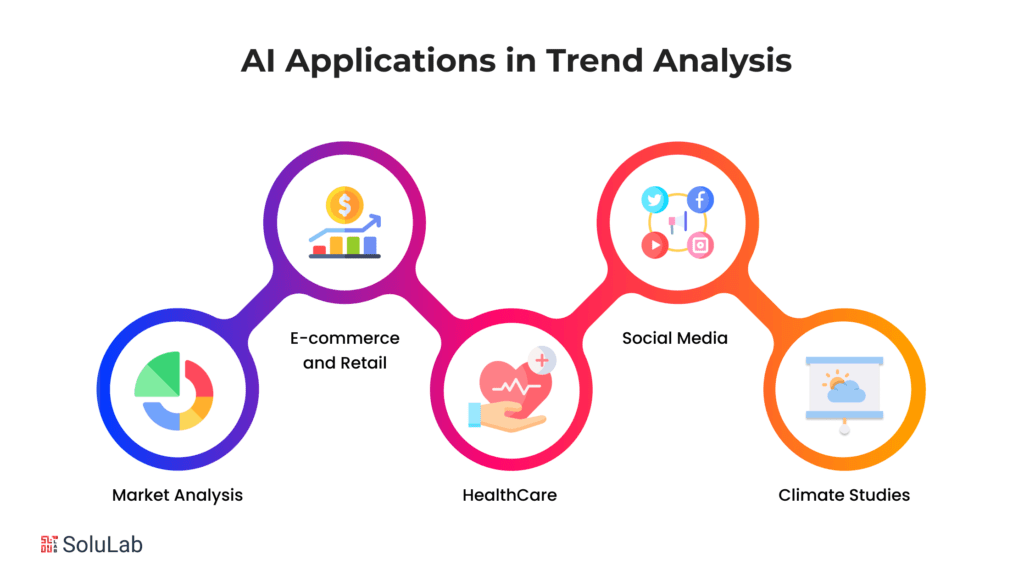
Examine how artificial intelligence (AI) is being used in many sectors for trend research. AI-driven solutions provide unprecedented capabilities for using data-driven insights and promoting well-informed decision-making, from forecasting market shifts to optimizing corporate strategy.
1. Market Analysis
By using machine learning algorithms to identify patterns and predicted insights from real-time data, leveraging AI in market research significantly improves the capacity to generate consumer intelligence and ensures accurate capture of market variations. For example, a health and fitness company may use a customized AI model to scan online discussions on current health trends and rival products, creatively matching their offers and digital marketing tactics to consumer needs.
With the use of technologies like natural language processing for sentiment analysis and predictive analytics for market demand and customer preference predictions, artificial intelligence (AI) makes data collecting and analysis more automated. With the help of AI, businesses can create data-driven strategies, optimize customer experiences, and launch focused marketing campaigns by carefully examining a wide range of data sources to understand and predict customer behavior and preferences. Market research techniques are being redefined both now and in the future by this fusion of AI and conventional approaches.
2. E-commerce and Retail
AI in trend analysis greatly improves comprehension of consumer preferences and market trends in the retail and e-commerce sectors, fine-tuning the foundation of online commerce. By analyzing customer behavior and spotting new trends, artificial intelligence (AI) assists businesses in making necessary adjustments to their inventory and marketing plans, such as stocking more sustainable items in response to consumer demand.
Retailers can forecast market trends, optimize pricing, manage inventory effectively, and increase consumer interaction using AI’s real-time analysis of large datasets. AI-driven recommendation engines provide personalized shopping experiences by examining each user’s unique purchasing habits and interests. This improves consumer satisfaction and increases brand loyalty.
3. HealthCare
Through careful study of health data trends and patterns, AI trend analysis in healthcare offers a crucial partnership between technology and medicine, paving the way for more personalized and proactive treatment. AI carefully sorts through a wide range of healthcare data, such as clinical trial results, medical records, and research, to identify new patterns and subtleties in the course of illness, the efficacy of therapy, and patient outcomes.
Medical experts may anticipate health concerns and modify treatment plans based on trends they identify thanks to this thorough investigation. AI in diagnostics uses novel approaches to analyze genetic data and medical pictures, looking for patterns and abnormalities that may indicate the development or progression of a disease. This allows for early and accurate identification and intervention, improving the prognosis of serious medical disorders.
Read Blog: Generative AI in Healthcare
4. Social Media
Businesses are using AI trend analysis to unearth previously unattainable insights from vast and varied amounts of user-generated material, revolutionizing the way they engage with social media data. By using cutting-edge algorithms to dive deeper into the complex web of interactions, feelings, and expressions, this analytical technique goes beyond standard methods and offers a more nuanced, sophisticated knowledge of public attitudes and impressions.
Sentiment analysis is one area where artificial intelligence (AI) really shines because it can analyze the nuanced emotional expressions of users and help businesses develop and adapt to better meet the needs and ideals of their customers. Through natural language processing, it helps businesses to effectively track how consumers perceive their brands and engage in social media conversations. It also allows them to react instantly to changing client demands and attitudes and spot areas for improvement and innovation.
5. Climate Studies
AI’s significant influence on climate trend research is an example of how environmental science and technology work together harmoniously to produce insights and solutions in the fight against climate change. Through the analysis of large amounts of meteorological data, AI explains concealed climatic patterns and trends in this complex dance, turning abstract statistics and patterns into meaningful stories about our changing planet.
Machine learning algorithms power this technological marvel, sifting through massive datasets to identify minute changes and abnormalities in climatic variables like temperature swings, precipitation totals, and air composition. By projecting complex climate models, these algorithms provide scientists access to a wide range of possible future climatic situations and facilitate the evaluation of various environmental initiatives and policies.
Conclusion
In summary, the emergence of artificial intelligence (AI) has ushered in a new age in trend analysis, transforming markets and the way that decisions are made. Artificial intelligence (AI) has become a potent tool for identifying trends, forecasting market moves, and gaining practical insights due to its capacity to sort through enormous amounts of data. AI trend analysis has countless applications in industries ranging from manufacturing to healthcare and retail to finance, allowing companies to stay ahead of the competition in today’s era.
Working with a reputable AI consulting company like Solulab becomes essential for companies looking to stay ahead of the curve. Utilizing technology and creative approaches, Solulab’s committed group of AI developers creates custom AI solutions that are suited to the particular requirements of every customer. Whether predicting customer behavior, streamlining supply chains, or spotting new trends, Solulab equips companies with the knowledge and resources they need to succeed in a world that is becoming more and more data-driven.
It is impossible to overestimate the extreme potential of AI in trend analysis, from uncovering previously unknown opportunities to reducing risks. Organizations that harness the potential of AI trend analysis put themselves in a successful and innovative position for long-term growth. Using AI for trend analysis with Solulab as your reliable partner opens up countless possibilities and steers your company toward an unmatched future of success and wealth.
FAQs
1. What is trend analysis, and why is it important for businesses?
Trend analysis involves examining historical data to identify patterns and predict future market trends. It’s crucial for businesses to stay ahead of the curve and make informed decisions in a dynamic marketplace.
2. How does AI improve trend analysis?
AI enhances trend analysis by automating data processing, detecting complex patterns, and providing real-time insights at scale. Its predictive modeling capabilities enable businesses to anticipate market shifts more accurately.
3. What are some practical uses of AI in trend analysis?
AI finds applications in various industries for trend analysis, including forecasting consumer behavior, optimizing inventory management, identifying investment opportunities, and personalizing marketing campaigns.
4. What are the challenges associated with implementing AI for trend analysis?
Challenges include data privacy concerns, algorithm bias, the need for skilled AI talent, and ensuring the ethical use of AI technologies. Overcoming these obstacles requires careful planning and adherence to best practices.
5. How can businesses integrate AI-powered trend analysis into their operations?
Integrating AI into operations involves investing in data infrastructure, AI technologies, and employee training. Collaborating with experienced AI development services providers can streamline the implementation process and maximize ROI.
6. Can you provide examples of AI-driven trend analysis in action?
Case studies illustrate the practical benefits of AI in trend analysis across industries. Examples include predicting customer churn in telecommunications, optimizing supply chain logistics in manufacturing, and identifying market trends in finance.
7. What does the future hold for AI in trend analysis?
The future of AI in trend analysis holds promise for advancements such as autonomous trend forecasting, augmented decision-making, and the integration of AI with emerging technologies like blockchain and IoT. Stay informed to leverage these developments for competitive advantage.




